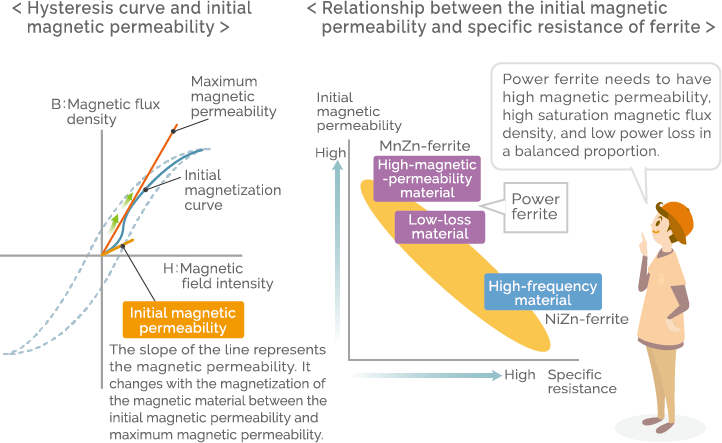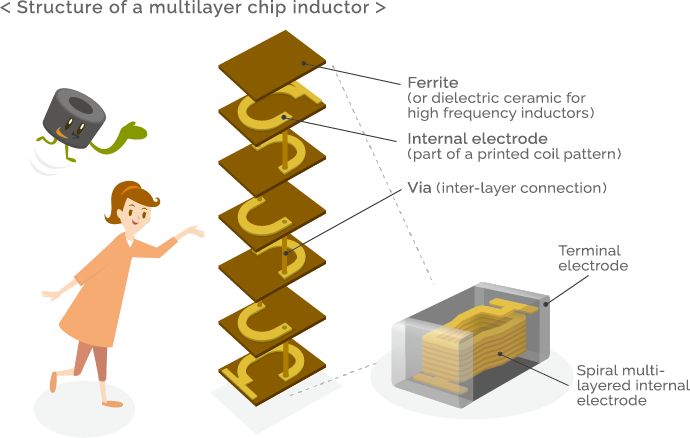Ferrite World
Vol. 8 Noise suppression of electronic devices and ferrite

Ferrite is utilized in RFID systems such as “Suica”
When multiple electronic devices with winding wire such as transformers and inductors are mounted on one circuit board, care should be taken for their direction. This is because if they are placed in parallel or in tandem, magnetic flux from coils is coupled, causing issues such as oscillation.
The RFID system called Felica proactively uses this magnetic coupling between coils, which is troublesome on circuit boards. The system is used in IC travel cards (e.g., Suica and PASMO), the Osaifu-Keitai mobile payment system, Mobile Suica, etc. It is an electromagnetic-induction communication system in which magnetic flux is exchanged between the antenna (loop coil) of the RFID tag incorporated in a card or mobile phone and the antenna on the reader/writer side to read and write information. Because the communication distance is only several centimeters, you need to put your card close to a reader/writer. However, since changes in magnetic flux from the reader/writer side are used as energy, the IC incorporated in the card can operate without a battery.
In some mobile phones with a Felica’s function, a magnetic sheet made up of soft magnetic material (TDK’s “Flexield” product) is placed on the back side of the incorporated antenna. This is because if there is a metal surface of a battery pack, printed circuit board, etc. near the antenna, then a problem may occur in the exchange of magnetic flux with the reader/writer. When magnetic flux is changed externally against an electrical conductor such as metal, an eddy current flows through the conductor and causes reaction magnetic flux, so that the magnetic flux change is blocked. This reaction magnetic flux cancels out magnetic flux from the reader/writer side, preventing it from reaching the antenna (for details on reaction magnetic flux, see Vol. 2 of this series).
The magnetic sheet is formed by mixing thin pieces and powder of high-magnetic-permeability soft magnetic material with plastic, etc. Soft magnetic material with high magnetic permeability well collects magnetic flux in a similar way a sponge absorbs water. Therefore, inserting the magnetic sheet between the antenna and the metal surface prevents reaction magnetic flux on a metal surface of a battery pack, etc., making the exchange of magnetic flux with the reader/writer side smoothly. A similar measure is needed for the reader/writer side. A magnetic sheet or ferrite plate is used in the back side of the antenna on the reader/writer side, such as automatic ticket gates in train stations, Felica-compliant systems in convenience stores, and kiosk systems.
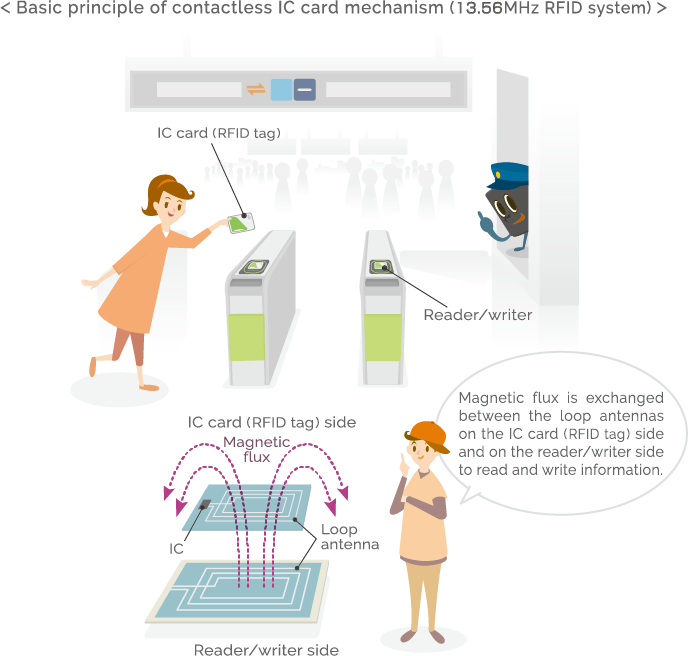
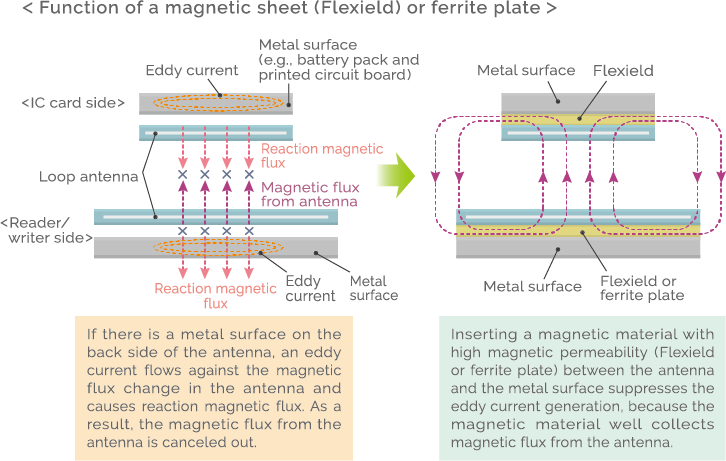
“Flexield” magnetic sheet utilized as noise suppression components
Energy loss is inevitable in energy transmission and conversion processes. For example, when an AC current is applied to the primary coil of a transformer, the generated magnetic flux flows through the core and electromagnetic induction generates electromotive force in the secondary coil. The magnetic flux change transmits energy, and at the same time, some of the energy is lost as heat in the core. This magnetic loss is called core loss. Metallic magnetic materials such as iron, particularly, have low electrical resistance, so they face the problem of heat generation due to eddy current mentioned above. This is called eddy current loss, and sharply increases in proportion to the square of the frequency in a high-frequency range. This heat generation is proactively used in applications such as induction cookers, IH (induction heating) rice cookers, and high-frequency welding, but metallic magnetic materials such as iron can never be used as high-frequency transformer cores.
Meanwhile, ferrite can be used as low-loss cores in a high-frequency range as it is a polycrystal consisting primarily of metal oxides and therefore features high electrical resistance. Also, the area of a ferrite core can be made smaller at a higher frequency, so ferrite contributes to the miniaturization of transformers.
In addition to eddy current loss, there is another kind of core loss called hysteresis loss. As described in Vol.7, the magnetization process of magnetic material draws a S-shaped closed curve called a hysteresis loop. When an AC current is applied to the coil, magnetization reversal is repeated with a hysteresis loop being traced. At the same time, magnetic loss proportional to the loop area occurs. This is called hysteresis loss. Therefore, high-frequency ferrite cores use materials in which crystal grains are made as uniform as possible and are thereby densified. This is how hysteresis loops become narrow S-shaped loops and hysteresis loss is reduced.
TDK’s Flexield is a material that has low magnetic loss (low loss) and shows high magnetic permeability (high mu) at 13.56 MHz (the operating frequency of Felica), so it is used in Felica-compliant mobile phones, etc. However, the magnetic permeability of a magnetic material changes depending on the frequency. Unfortunately, there are no materials that have low-loss and high-mu properties in the entire frequency range. Even Flexield causes a significantly high magnetic loss in the high-frequency range from 100 MHz to 1 GHz or more, but the proactive use of this magnetic loss makes it possible to use Flexield as noise suppression components.
Generally, noise is a current that has a much higher frequency component than the frequency of the signal current and is emitted from ICs, flat cables, etc. in electronic equipment. Thus, attaching Flexield to such surfaces makes it possible to convert high-frequency noise into heat and thereby to eliminate it using the magnetic loss of the magnetic material in Flexield. In mobile phones that have increasingly high-density circuits, noise generated by the devices themselves badly affect the circuits; this is called a “self-poisoning” problem. As a solution to this, TDK’s Flexield provides excellent effects like a “magical healing ointment.”
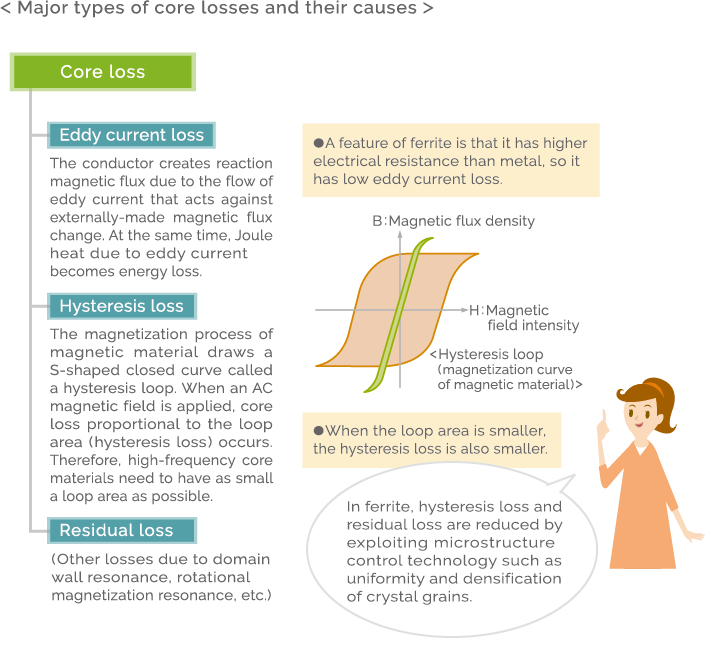
Chip beads and common-mode filters that utilize advantages of ferrite
There are noise suppression components called chip beads, which use ferrite. They are electronic components that have a simple structure in which the conductive line is passed straight through or turned several times in the ferrite material. When a signal passes through the conductive line in a chip bead, high-frequency noise component included in the signal current is removed.
Chip beads are electronic components that have the properties of both inductors (coils) and resistors. A coil produces electromotive force in response to a change in the current so that the change is prevented (self-induction phenomenon). Therefore, a coil passes a direct current smoothly, but it has an impedance for an alternating current (resistance to an alternating current), and act as a brake on an alternating current. This becomes more marked at higher frequencies, so high-frequency noises are reflected.
Noise exists over a wide frequency band. In a chip bead, the inductor component (X) of the coil becomes main in up to a certain frequency range to reflect noise, and the resistor component (R) becomes main in a higher-frequency range to absorb noise and convert it to heat. A frequency at which such a function switches is called the R-X cross point. In circuit design, chip beads with an appropriate R-X cross point are selected according to the frequencies of noises to be removed.
Common mode noise suppression is increasingly important in suppressing noise in electronic devices. Noise that has inward and outward lines like signal current is called differential mode noise, and noise that flows in the same direction regardless of the inward or outward line is called common mode noise. With increased digitization and higher frequency in electronic devices, radiation noises generated from interface cables, etc. penetrate and badly affect other electronic devices as common-mode noise current through floors, ground surfaces, etc. Therefore, it has become necessary to incorporate a common-mode filter into high-speed interface connectors such as USB and HDMI connectors.
A common-mode filter is an electronic component in which a ferrite core is wound with two conductive wires in the same direction. When a current flows through the coil, magnetic flux is generated in the core. A signal current is a differential mode current, which has the opposite inward and outward lines, so magnetic flux is generated in opposite directions and therefore is canceled out in the core. Therefore, a common-mode filter does not affect signal currents. Meanwhile, common-mode noise currents flow in the same direction, so magnetic flux generated in the core has the same direction; thus, the magnetic flux is combined and thereby strengthened. This serves as a brake to prevent common-mode noise currents from passing. A common-mode filter is a noise suppression component that passes signal currents without attenuating them, while smoothing out signal waveforms. Its applications are expanding into not only electronic devices but also various automotive LANs, etc.
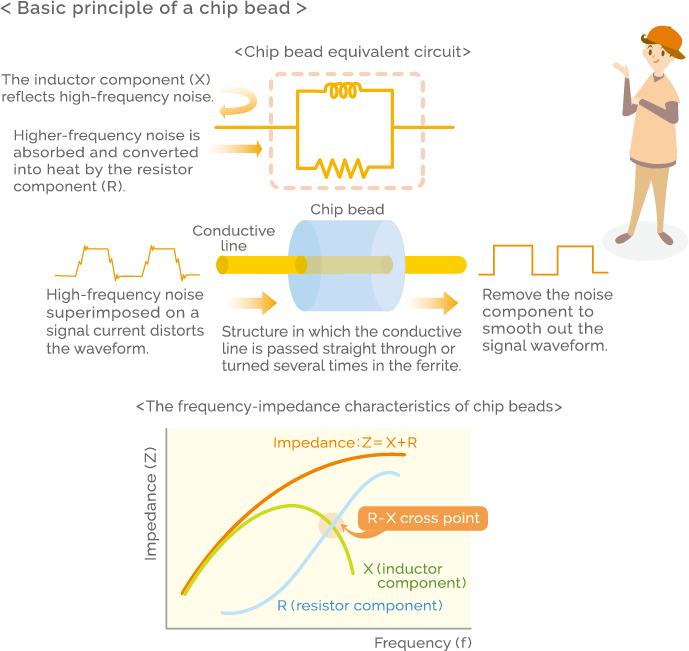
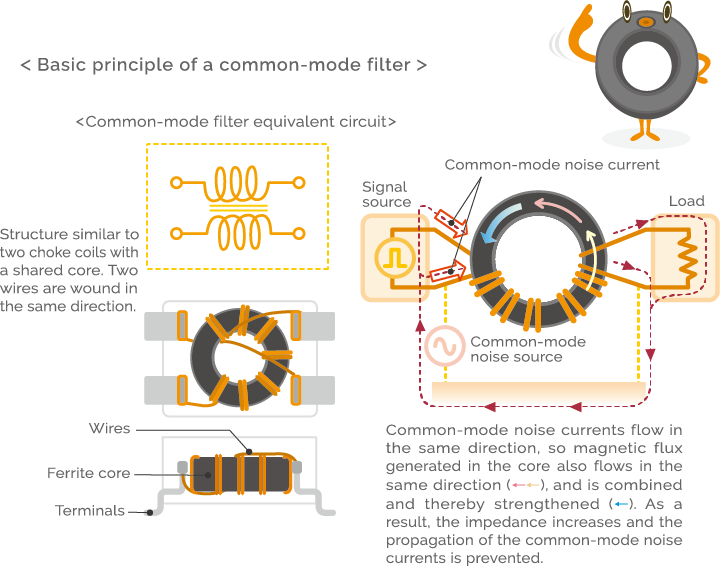
TDK is a comprehensive electronic components manufacturer leading the world in magnetic technology



